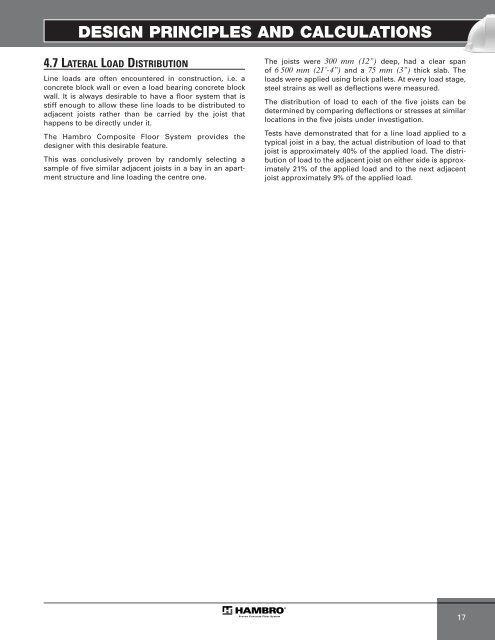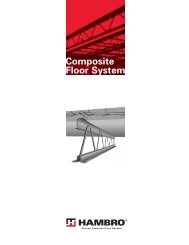MEP-Technical Manual CDN 0408.qxd - Hambro
MEP-Technical Manual CDN 0408.qxd - Hambro
MEP-Technical Manual CDN 0408.qxd - Hambro
Create successful ePaper yourself
Turn your PDF publications into a flip-book with our unique Google optimized e-Paper software.
DESIGN PRINCIPLES AND CALCULATIONS<br />
4.7 LATERAL LOAD DISTRIBUTION<br />
Line loads are often encountered in construction, i.e. a<br />
concrete block wall or even a load bearing concrete block<br />
wall. It is always desirable to have a floor system that is<br />
stiff enough to allow these line loads to be distributed to<br />
adjacent joists rather than be carried by the joist that<br />
happens to be directly under it.<br />
The <strong>Hambro</strong> Composite Floor System provides the<br />
designer with this desirable feature.<br />
This was conclusively proven by randomly selecting a<br />
sample of five similar adjacent joists in a bay in an apartment<br />
structure and line loading the centre one.<br />
The joists were 300 mm (12”) deep, had a clear span<br />
of 6 500 mm (21’-4”) and a 75 mm (3”) thick slab. The<br />
loads were applied using brick pallets. At every load stage,<br />
steel strains as well as deflections were measured.<br />
The distribution of load to each of the five joists can be<br />
determined by comparing deflections or stresses at similar<br />
locations in the five joists under investigation.<br />
Tests have demonstrated that for a line load applied to a<br />
typical joist in a bay, the actual distribution of load to that<br />
joist is approximately 40% of the applied load. The distribution<br />
of load to the adjacent joist on either side is approximately<br />
21% of the applied load and to the next adjacent<br />
joist approximately 9% of the applied load.<br />
17



